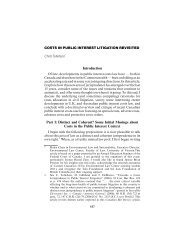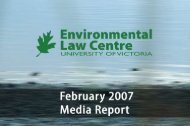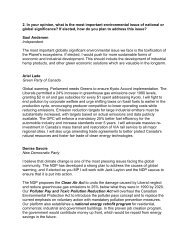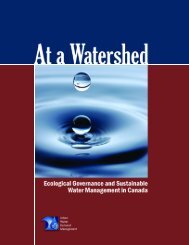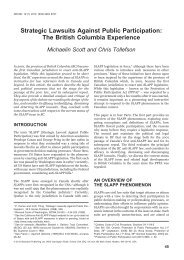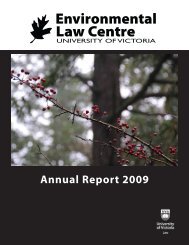Peeling back the Pavement - POLIS Water Sustainability Project
Peeling back the Pavement - POLIS Water Sustainability Project
Peeling back the Pavement - POLIS Water Sustainability Project
Create successful ePaper yourself
Turn your PDF publications into a flip-book with our unique Google optimized e-Paper software.
CASE STUDY 6<br />
TORONTO’S MULTIDISCIPLINARY APPROACH TO<br />
RAINWATER MANAGEMENT<br />
The City of Toronto, Ontario is in <strong>the</strong> process of implementing a 25-year plan to help<br />
solve water pollution in <strong>the</strong> city. Approved in 2003, <strong>the</strong> Wet Wea<strong>the</strong>r Flow Master Plan<br />
(WWFMP) represents a comprehensive approach to urban stormwater governance,<br />
with a focus on reducing pollution caused by stormwater runoff and combined sewer<br />
overflows (CSOs).<br />
In 1987, <strong>the</strong> International Joint Commission identified <strong>the</strong> City of Toronto waterfront as<br />
one of 43 polluted Areas of Concern in <strong>the</strong> Great Lakes Basin. The geographic boundary<br />
of <strong>the</strong> City of Toronto spans six different watersheds and from <strong>the</strong>se watersheds pollution<br />
from CSOs and stormwater runoff ultimately flows into Lake Ontario.<br />
The WWFMP takes a hierarchical approach to rainwater management. It starts with<br />
source controls, which deal with rainwater where it falls. It <strong>the</strong>n focuses on conveyance<br />
system measures and, finally, end-of-pipe facilities.<br />
The plan identifies a host of measures to be implemented on individual lots including<br />
using porous surfaces ra<strong>the</strong>r than concrete or asphalt, especially in parking lots; planting<br />
trees to help capture runoff; a green roof incentive pilot program; and a rainwater harvesting<br />
demonstration project at Exhibition Place, <strong>the</strong> city’s largest entertainment venue.<br />
As <strong>the</strong> city’s aging sewer infrastructure requires replacement, it will be updated with<br />
new purposefully “leaky” pipes that allow captured stormwater to seep into <strong>the</strong><br />
ground. What isn’t captured by <strong>the</strong> surrounding soil or sand will re-enter <strong>the</strong> storm<br />
sewer pipes and will be controlled through end-of-pipe measures. In addition, a “search<br />
and destroy cross-connections” program aims to fix linkages between drainage pipes<br />
that are erroneously connected to sanitary sewers.<br />
The total capital cost for <strong>the</strong> 25-year WWFMP is approximately $1 billion, or $42 million<br />
per year. Operational and maintenance costs to implement <strong>the</strong> capital projects are<br />
estimated at $16 million annually.<br />
Complementing <strong>the</strong> WWFMP, <strong>the</strong> City has also developed <strong>the</strong> award-winning Toronto<br />
Green Standard (TGS), which outlines performance measures and guidelines for sustainable<br />
site and building design for new developments. It was developed collaboratively<br />
across a number of divisions within <strong>the</strong> city, highlighting Toronto’s progress toward<br />
integrating land- and water-use management and decision making.<br />
Sources on page 67.<br />
Photo (facing): hughreynoldsphotography.ca<br />
53



